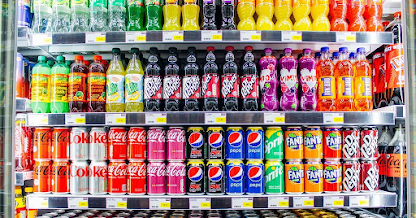Difference between Carbonated and Non-Carbonated Drinks
The biggest difference between the two is, of course, carbonation. Non-carbonated drinks are frequently less sweet than carbonated drinks since they do not contain sugar or artificial sweeteners.
Carbonated soft drink is a drink that bubbles and fizzes with carbon dioxide gas. The process by which the gas dissolves in the drink is known as carbonation. This process can occur naturally, such as in naturally carbonated mineral water that absorbs carbon dioxide from the ground, or by man-made processes, as is the case in most soft drinks and soda waters.
Carbonated beverages are created by adding carbon dioxide, making them fizzy and giving drinks a bubbly feel. Carbon dioxide molecules are soluble, which means they dissolve in liquids and form carbonic acid. This process unfolds at the rate where the bubbles aren’t able to escape, resulting in a beverage that tickles your tongue and gives you that pleasant fizzy feeling. This makes carbonated drinks more refreshing than non-carbonated beverages because they tend to contain higher acidity and sugar levels, which creates a broader range of flavours.
Every carbonated beverage has its own unique ratio of ingredients which determines how fizzy it will be, how long the bubbles will tickle your tongue, and what flavour it will have. The carbon dioxide needed to make a carbonated soda varies according to its ingredients. The ratio might change depending on using cane sugar, corn syrup, or other sweeteners because they all have different properties and will result in different amounts of carbon dioxide needed to make the beverage fizz properly. Carbonated Drinks include Soda (Without Sugar), Sports Drinks And Energy Drinks.
Non-carbonated beverages, on the other hand, do not contain carbon dioxide or have a fizzy flavor. Non-carbonated drinks lack that particular zing because the carbonation process is not used. A wide variety of beverages are included in this group, such as juice, tea, coffee, smoothies, water, etc.
Non-carbonated drinks are typically clear and don’t have any bubbles because the carbon dioxide molecules have been removed. This gives them a lighter taste because they don’t have as much sugar or acidity as carbonated drinks.
Most of the soft drinks available in the market are soda. In short, any kind of drink which doesn’t have any sort of alcohol can be regarded as a soft drink. Another name of soft drink is a carbonated beverage as this kind of drink has fizz. Generally, fruit juice doesn’t contain fizz because it is made out of either fruit pulp or fruit-based formula. But that is not the case with soft drinks, they are made from carbonated water and it consists of carbon dioxide gas. In simple terms, soda or carbonated water is a container of water and carbon dioxide
Many sodas have a pH as low as 2, which is why they taste so sour! Non-carbonated beverages have a slightly higher pH because there are no chemical reactions between the different ingredients inside them. This makes carbonated beverages more acidic than non-carbonated ones.
Energy Drinks Vs Sport Drinks
Energy drinks are commonly known as a drink that gives you an instant boost of energy to help you push through your tasks with increased alertness and focus. What is most notable about energy drinks is their ingredients, which often comprise mainly caffeine, B vitamins and sugar, and occasionally some additional ingredients such as Taurine and ginseng extract.
Another uniqueness of energy drinks is how much variety is available, many serving a specific purpose such as to be a workout drink or even as a drink for helping students who need to burn the midnight oil.
Energy drinks are frequently marketed as a boost to physical and mental performance. Because caffeine is easily absorbed through the stomach, carbonation facilitates its absorption.
The cool temperature of energy drinks gives the body a quick jolt, causing it to become more attentive. The addition of carbon dioxide stimulates your neurological system even more. With each sip, you’ll experience a tingling, refreshing sensation that is both refreshing and exhilarating.
Sports drinks on the other hand are drinks that are used to rehydrate your body after exercise, where there are three types available: isotonic, hypertonic, and hypotonic.
The three types differ in their amount of salt and sugar, where hypotonic sports drinks contain the least amount followed by isotonic, and finally, hypertonic sports drink with the most.
Having a different composition, each type of sports drink serves a slightly different purpose as well, which is as follows:
- Isotonic drinks contain an equal amount of salt and sugar to those in your body and work to replace fluids lost during exercise with the help of carbohydrates.
- Hypertonic drinks are made to supplement your body’s daily carbohydrate intake and replace your glycogen level after exercise.
- Hypotonic drinks have a higher concentration of salt and sugar than the human body which allows fluid to be quickly replaced in your body.
So from what you can see, sports drinks are generally made to be post-workout drinks that help you replenish your lost fluids or glycogen.





Comments
Post a Comment